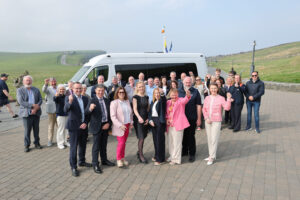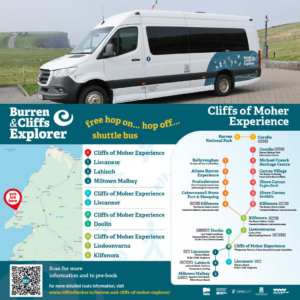The Burren and Cliffs of Moher UNESCO Global Geopark Joins EUROPARC Federation
(c) Burren and Clifs of Moher UNESCO Global Geopark
There is power in numbers! We are proud to introduce the newest EUROPARC member: The Burren and Cliffs of Moher UNESCO Global Geopark. Get to know the Park!
A new member from Ireland!
We are thrilled to welcome The Burren and Cliffs of Moher UNESCO Global Geopark as a new member of the EUROPARC Federation! Located in County Clare on Ireland’s wild Atlantic coast, this breathtaking region is world-renowned for its karst landscape, rich biodiversity, and deep cultural heritage.
The Geopark encompasses a variety of stunning natural features, including limestone pavements, underground cave systems, and the iconic Cliffs of Moher. It is home to rare plant and animal species, historic monuments, and a vibrant local community dedicated to sustainability.
A Clear Goal: Reducing Tourism’s Impact
The primary mission of the Geopark is to reduce the environmental and cultural impact of tourism, both within and beyond the Geopark boundaries. To achieve this, they have developed the Geopark Code of Practice for Sustainable Tourism Businesses, an online platform currently used by 69 local businesses.
This tool helps businesses track a range of sustainability metrics such as:
- Carbon footprint
- Energy usage
- Waste management
- Biodiversity actions
- Staff education
- Community cleanup initiatives
All submissions are externally audited by qualified experts, and participation in the Code is mandatory for membership in the Burren Ecotourism Network.
The Burren and Cliffs of Moher UNESCO Global Geopark are currently in the process of applying for the European Charter for Sustainable Tourism (ECST). We look forward to welcoming them and all their experience in the EUROPARC Sustainable Tourism network!
Learn more about the ECST here.
Education at the Heart of Conservation
The Burren and Cliffs of Moher Geopark strongly believes that education is essential to protecting natural, geological, and cultural heritage.
Key educational initiatives include:
- The publication of “Stone, Water and Ice,” an illustrated book explaining the geology, archaeology, and biology of Geopark sites.
- Outdoor educational signage placed throughout the Geopark to engage visitors on-site.
- The Geopark Academy, an annual conference bringing together researchers, community members, and stakeholders to share new insights and foster local engagement.
Interview Spotlight: What EUROPARC Membership Means
We spoke with Carol Gleeson, the Manager of the Tourism Department at the Geopark, to learn more about their vision and how joining EUROPARC supports their goals.
What does this new membership mean for the Burren and Cliffs of Moher Geopark?
Joining the EUROPARC Federation strengthens our commitment to sustainable tourism. The European Charter for Sustainable Tourism (ECST) gives us a globally recognized framework to deepen partnerships with national agencies like the National Parks and Wildlife Service (NPWS) and to further empower local communities and businesses in conservation-focused development.
Balancing Tourism and Nature

(c) Burren and Cliffs of Moher UNESCO Global Geopark
The Burren receives large numbers of visitors each year. Balancing that popularity with protection efforts is no small task.
“We take a dual approach: a regional destination management plan and our sustainable business code. Our action plan addresses infrastructure, mobility, business sustainability, climate action, and heritage protection, guided by measured indicators. This has helped County Clare become the first GSTC-Certified Tourism Destination in Ireland and the UK (certified April 2025).”
🔗 Learn more here.
🔗 Sustainable Tourism Code.
Community-Driven Innovation: Shuttle Bus Service

One of the Geopark’s most exciting recent projects is the Burren & Cliffs Explorer Shuttle Service. This free hop-on, hop-off bus connects the Cliffs of Moher Visitor Centre and Burren National Park with local towns.
“This service reduces car traffic in protected areas and boosts local economies. It’s a joint effort by Clare County Council and the NPWS to provide a more sustainable visitor experience.”
🚍 Featured stops:
- Miltown Malbay
- Liscannor
- Doolin
- Kilfenora
- Lisdoonvarna
- Corofin
- Ballyvaughan
🔗 Details: cliffsofmoher.ie/burren-and-cliffs-of-moher-explorer
A Decade of Impact: Achievements in Conservation and Research
Over the past decade, the Geopark has gained international recognition for sustainable tourism management and geological research.
- Established in 2008, the Burren Ecotourism Network now includes 65 businesses and has won multiple international awards.
- Their Code of Practice, introduced in 2019, is a unique, evidence-based model fully managed by the Geopark and Clare County Council.
- Academic partnerships have led to notable fossil discoveries, including a shark tooth fossil find featured by RTÉ Science.
🔗 Read more - Over 500 local residents have participated in their evening geology courses.
- The Geopark Academy brings research to life for the public and strengthens ties between academia and community.
Welcome to the EUROPARC Family!
We are proud to count the Burren and Cliffs of Moher UNESCO Global Geopark among our members. Their innovative, community-led approach to conservation and tourism is a model for Protected Areas across Europe.
Together, we move forward in our shared mission to protect nature while building resilient, sustainable communities.
Member Consultation on the EUROPARC Strategy
Julian Alps Parks Await EUROPARC Transboundary Re-Certification After Five Years of Progress
(c) Julian Alps TBA
Following Nature Design
A New Chapter for the Julian Alps Ecoregion
In 2025, the Julian Alps Transboundary Ecoregion—made up of Triglav National Park (Slovenia) and Prealpi Giulie Nature Park (Italy)—is under re-evaluation for the EUROPARC Transboundary Parks Programme. The process, repeated every five years, is not just an assessment. It is a reflection of continued commitment to cross-border nature protection and collaboration.
The outcome of this year’s re-evaluation is not yet known. A verifier’s report will be submitted to the EUROPARC Steering and Evaluation Committee (STEC) and then the Council for final decision. Until then, the Parks look back on five years filled with progress and connection.

Stronger Together—Even in Crisis
From 2020 through 2025, the partnership between the two Parks grew stronger—even when direct contact was limited. The COVID-19 pandemic disrupted travel and delayed several activities. Still, both teams found creative ways to maintain momentum. Online meetings became routine. Frequent phone calls kept coordination tight. Staff members stayed in close contact, and mutual trust deepened.
This cooperation didn’t just survive—it adapted and thrived.
Highlights from 2020–2025
In 2020 and 2021, the parks shifted their efforts online. They held the 6th and 7th Transboundary ECST Forums digitally and took part as a pilot region in the DINALPCONNECT project. Steering committee meetings continued without pause, thanks to video conferencing.
By 2022, the focus turned back to the field. The Parks identified and tested a new transboundary connecting trail. They also launched the UNESCO Julian Alps Transboundary Biosphere Reserve nomination process in December. That same year, they hosted the 8th ECST Forum in Venzone.
The following year brought major milestones. In 2023, the parks signed a formal cooperation agreement in June. They also presented their UNESCO MAB dossier and co-organised the ECST Conference in Bled. In October, the 9th ECST Forum took place in Log pod Mangrtom.
2024 marked a year of visibility and celebration. UNESCO officially recognised the Julian Alps as a Transboundary Biosphere Reserve. The Parks promoted the area together at WTM London and the Italian Biosphere Reserve conference. They launched community events, named new ambassadors, and planned new cross-border cycling trails. In addition, they joined each other at major events—like the 100-year anniversary of Triglav National Park and a school opening in Resia.

(c) Julian Alps TBA
Building on Shared Foundations
Over time, the Parks have built a strong base of recurring activities. These include school exchanges, the “Youth at the Top” initiative, annual joint events, and exhibitions in both countries. Teams regularly exchange articles, attend international forums, and promote the area through local and regional media.
Partnerships go beyond events. Staff from both sides collaborate in the Danilo Re TB team and work together on EU-funded projects. This steady cooperation strengthens local engagement and helps the Transboundary Ecoregion speak with one voice.

(c) Julian Alps TBA
Planning the Future, Together
The Parks have not only looked back—they’ve looked ahead. Since 2022, they have co-developed several guiding documents. These include the Partnership Agreement that launched the UNESCO process, the official 2023 candidacy dossier, and a new Action Plan (2025–2029). These tools will guide their cooperation for years to come.
They also continue to share knowledge beyond their borders. In 2023 and 2024, they presented their model of transboundary governance to delegates from Laos, Vietnam, Norway, and Finland. Their experience now serves as a best-practice case in Europe and beyond.
Awaiting the Next Step
As they await the results of the 2025 EUROPARC re-evaluation, Triglav National Park and Prealpi Giulie Nature Park remain hopeful. Their work over the past five years reflects deep commitment, shared goals, and a clear vision.
Whether recognised again this year or not, the Julian Alps Transboundary Ecoregion has already proven its value—as a bridge between communities, cultures, and conservation goals.
Here is your chance to become a Certified Transboundary Area, too:
Welcoming visitors: How to positively include visitors into a Protected Area
Three case studies highlighting successful ways to welcome visitors in Protected Areas.
Welcoming visitors: How to positively include visitors into a Protected Area
Protected areas and tourism departments can enhance the visitor experience by making nature more accessible, inclusive, and easy to navigate—without harming the environment. This means creating clear signage, accessible trails and entry points, user-friendly maps and apps, and offering services that cater to a range of needs and abilities. By designing experiences that are welcoming and informative, visitors feel safe, inspired, and more connected to nature. When access is thoughtfully managed, it supports both a positive user experience and the long-term health of natural areas.

(c) Latgales Tūrisma asociācija
Case Study 1: Hiking boom and the necessity to be present
With the recent pandemic, many people were introduced to their local landscapes and experienced first hand benefits to spending more time out in nature. This increase in activity was an opportunity for the Latgale Tourism Association who saw this as an opportunity to diversify the options available to visitors in the area. Read how they implemented projects to establish long distance hiking trails within and across landscapes, focusing on facilitating a good user experience.
Full Case StudyCase Study 2: Creating visitor profiles to guide the customer-centered service development of Metsähallitus Parks and Wildlife Finland

(c) Metsähallitus Parks and Wildlife Finland
Just like we celebrate the diversity of nature, we should recognise and celebrate the diversity of visitors and their expectations or needs. Metsähallitus Parks and Wildlife Finland have done exactly that using a service design approach based on visitor insight. This in-depth research led to the highly successful development of a diversity of visitor profiles which have been used to mark hiking trails and much more, allowing the park to nudge the visitors into behaviours which best match their needs, leading to better experiences.
Full Case Study
Lobau Together Week. (c) Susanne Leputsch
Case Study 3: Visitor Management Lobau 2023+ customised solution for periurban challenges in the Viennese share of Donau-Auen National Park
Our third example is a collaborative approach of identifying challenges and solving them together with the local stakeholders including police and political decision-makers. Read about the “Lobau Together Weeks” which resulted in a better relationship between the many people visiting this periurban park. Perhaps your park has implemented something similar?
Full Case StudyThese case studies show a more positive view of visitor management in Protected Areas, but we also understand that some areas have trouble with “overtourism”. To explore techniques employed to manage the negative effects of high visitation rates, read our previous article.
Do you also have interesting experiences, projects or challenges that you have overcome in successful and creative ways? Consider submitting a case study and be featured in our EUROPARC news. Please visit our Knowledge Hub or reach out to us if you have any questions!
